
Acting fly-on-the-wall, Alexandra Bruggisser, took a seat in the indoor arena at SIEC watching the two-day riding clinic run by Christoph Hess. She reports on the clinic and judge’s workshop run by the international Dressage and Eventing judge, who is also the director of the German Federation’s program for developing horses and riders. In this first part we look at the younger horses involved in the clinic, next part, a training strategy for producing effective young riders and then a glimpse of the older horses that attended the clinic.
This is another treasure from our archives…
I can’t help comparing Christoph Hess to the university lecturers I am constantly exposed to, and if he was one, I am sure his students would be topping the state; not just in the subject he taught, but the general course known as life too!
After a hectic second year at uni there couldn’t have been a sweeter way to top off the year than the opportunity to watch the clinic held at SIEC with Christoph Hess. A quick Google revealed that he really is the ant’s pants of the scene! As part of my own ongoing challenge of learning about Dressage, and now as a Level 1 coach thinking about how best to teach Dressage, I’ve been wondering if there are people out there who have studied the art of teaching Dressage as well as the highly-developed training scale for horses. It became obvious at the clinic that Christoph is such a person, well versed in the art and science of teaching as well as thoroughly understanding the training scale and the nature of the horse. Christoph left an imprint on everyone who passed through the indoor. Not only did all the riders at this clinic feel their approach was refined and given clear direction, but the judges and spectators were also left with a systematic concept of training. Again, the basics formed the foundations for all other work, and positive reinforcement was celebrated and infectious! The basics are introduced here with three young horses.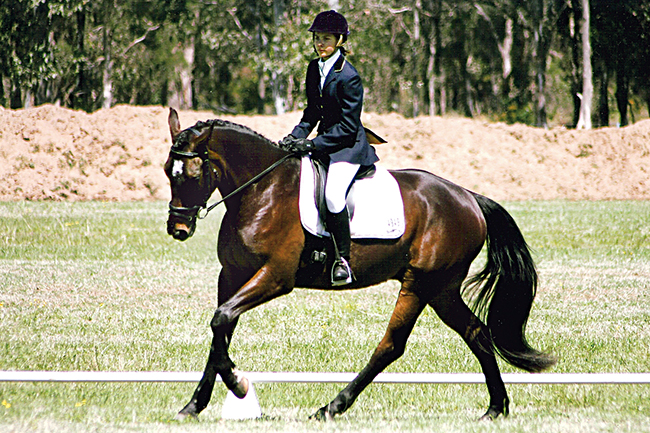
Grace Kay and Elite Dynasty
First up, Grace Kay, a well-known name within young rider circles and, it seems, soon to be a fierce competitor in young horse classes. Today she is riding Elite Dynasty or ‘Dino’, by Celerity Park Starlight (Sky High), a big, leggy three-year-old gelding she found unbroken and running with thirty other horses in a paddock at Celerity Park stud near Nabiac in May. By far the youngest horse and rider combination at the clinic, Grace is fourteen and Dino has only been broken in for five months. The clinic is his fourth outing. Never unplaced, he is already qualified for the young horse classes next year. Grace describes him as being ‘quiet but quirky’, and it seems Christoph enjoys working with a pair like this. A 20 x 60m arena has been set up within the indoor but Grace is instructed to ride outside it on the larger arena itself.
story continues below the advertisement
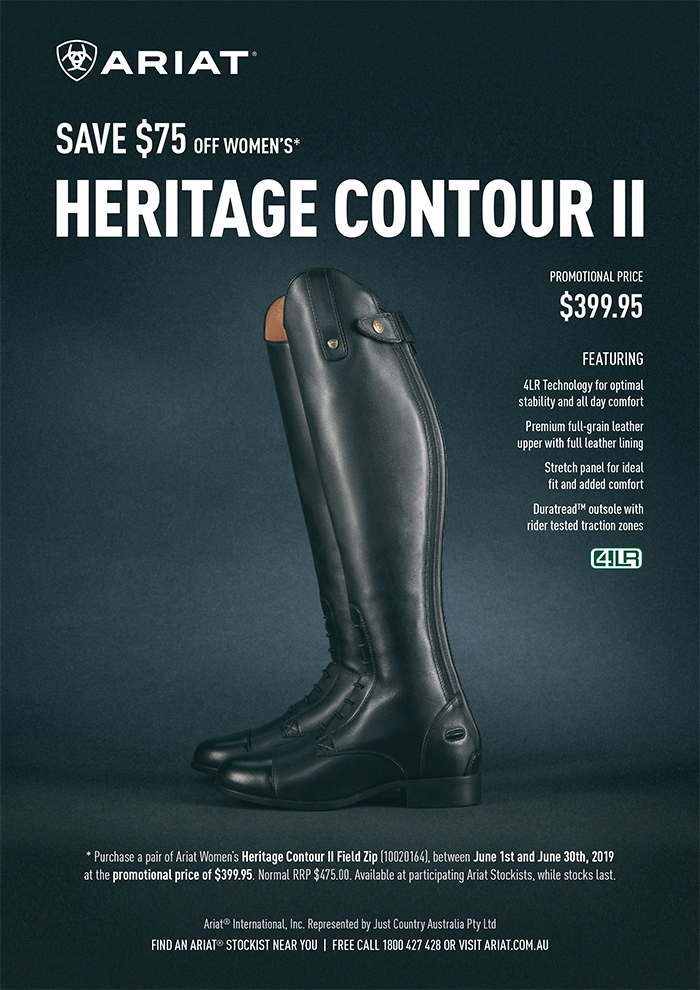
This is an approach we see repeated over the following days, the reason being that it is easier for the horse to find his balance on the larger arena and we are trying to make it easy for him. The work has a clear emphasis on forward and stretching… “Super canter. Come, come, come.” I’m sitting near Kim Peters (the coach who has guided Grace to her successes and assisted with breaking Dino to saddle) and Chris, Grace’s Mum, who is covering her eyes as Grace and Dino pelt around in a huge canter.
Chris’s eyes pop open again to see the improvement in the horse’s freedom from the shoulder. “And now, next long side in a little bit light seat. (Dino breaks into trot) Canter again, and bring your body in front. So, very good. And give both reins. Ja, very good. 100% the right way to school a horse 11 months under the saddle (and it’s not even that long!). Now next long side, long rein, as long as possible. Carlos this is for you because Mr Stecken likes it!” A reference to Carlos De Cleermaecker, a spectator and who, like Christoph, has trained with the famous Mr Stecken, Ingrid Klimke’s current coach. “Long rein, as long as possible. Like that, long rein! Get the message of Mr Stecken here in Australia – it is international. Inside leg, inside leg and now longer rein as long as possible so that he balances his body and then on the next long side transition to trot, rising.”
On the day of the judge’s workshop… “I think from the judge’s point of view this horse is 100% clear in rhythm. Which is the first step of the scale of training, secondly the rider is able to ride the horse in the right tempo, which is very closely connected to rhythm. She is not hurrying the horse, the horse is not lazy, it’s just going forward but not running away. The next step of the scale is the relaxation or suppleness. The horse for me is totally supple. It has a very nice way of swinging and a good stretching position in all parts of its body. Then the next part is the contact and in the German rule book it says, and I think it is very sympathetic and sensible, Das Pferd soll Anlehnung suchen, the horse has to seek the contact. Und der Reiter hat das zu gestatten. And the rider has to say, yes you can seek the contact, I accept it. A lot of riders use draw reins or the ‘German rein’ to make the horses very short in the neck. But then the horse has no chance to balance the body. This horse has a very well stretched neck and so is able to balance his body: the German word is Balancierstange, the balance stick of a circus tightrope walker, and it is a similar situation for the horse. Therefore from the biomechanic point of view it is very important that the horse is able to stretch the neck as much as possible. In the first months of training you can kill a horse or bring them 100% in the right direction of training and then at the end of the day when everything goes the right way you will have a Grand Prix horse.”
“However, many horses are killed when they are young and I want to this horse as an example, when Grace would get the advice from a stupid riding teacher to make the horse go round because they say the horse is too much on the forehand, it has to be more up in the poll, you would kill the horse. In the end the horse would accept it, like the Australian guy, Andrew McLean says, learned helplessness. So I am very happy seeing this horse. For me this is a world-class canter. And if I was to give a mark, at least…a 9. Ladies and Gentlemen, at least a 9. When you give a 10 you are not wrong, when you give an 8 you are nearly wrong. I would give a 7.5 for the trot and the same for the walk. Not quite an 8, but more than a 7. The trot has the most capacity to be improved.” Knowing this, we will all observe Grace’s results next year with heightened interest!
Christoph’s lessons continued with the integration and synthesis of a vast quantity of experience and knowledge across an array of areas, using his communication skills to achieve the desired free way of going and effectively allowing an audience to understand and lap up the information on offer. A riding teacher, a trainer’s trainer and a horse’s friend – a coach!!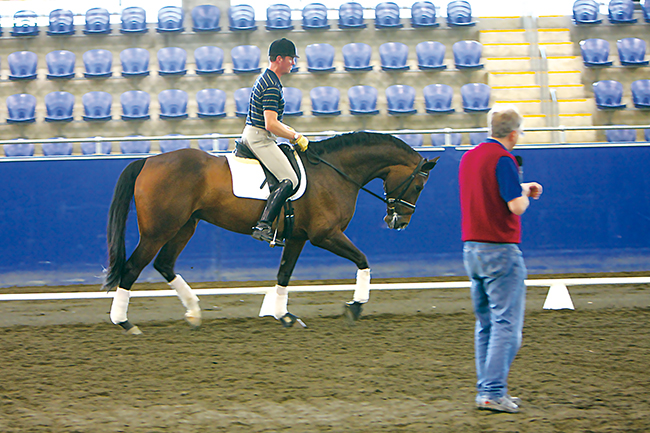
Riding in rhythm – Matthew Dowsley and Welton Fynne FF
World Equestrian Games representative Matthew Dowsley and his new partner, Flora Freeman’s eight-year-old Hanovarian mare, Welton Fynne FF, Lucy, keep the compliments flowing. “I know Matthew now quite well and what I want to point out with him is that he is a rider with a very nice feeling. He rides the horses with a very nice rhythm, which many riders can, but he is able to ride the horse in a very good tempo too. You can ride the horse in rhythm, but the tempo can be too slow or too fast, and Matthew has the feeling and each step he is riding on each horse is in the optimum tempo for the horse.”
Lucy is over 17hh and has had a foal; Christoph likens her stage of training more to that of a six year old. “It is good that this young horse is not schooled too early. If you have very big horses, don’t start with them too early. Give the young horses, when they are very huge, more time. They need more time to find their balance.”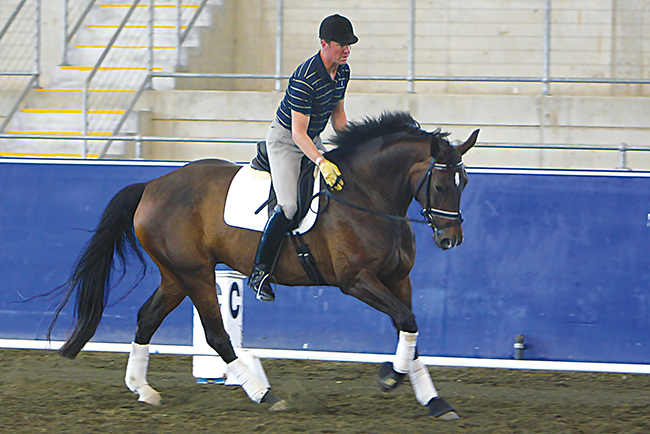
Wewltenfyne and Matthew show the forward seat and the encouraging forward giving rein
Backing up his theory of physical development… “Now trot, rising trot. In this case, I like the German word more, it is Leicht Traben. It means easy trot, light trot. Rising to me is a little bit mechanical, up and down, and the philosophy behind it is to make it easy. This mare is a very tall horse but a little bit weak. If Matthew is sitting the whole time, it is too much pressure for her. I also discussed with Matthew, who is a top class Grand Prix rider and is always sitting very straight, that with a young horse, bring your upper body into the forward position. In German we say the Remontasitz. A special position for a young horse. A Remonta is a young horse. The old guys use it, but now the new generation doesn’t, it is a perfect way to describe it. And Matthew does it very well.” I had never heard of this Remontasitz and spent several evenings scrutinising old issues of THM for a mention in stories and evidence in pictures. As it turns out, one of my idols, Ingrid Klimke, is one of several riders who does ride slightly in front of the vertical on her young horses. The picture is not unbalanced, but rather gives a feeling that the horse and rider share a connection, that they are in harmony with one another.”
story continues below the advertisement
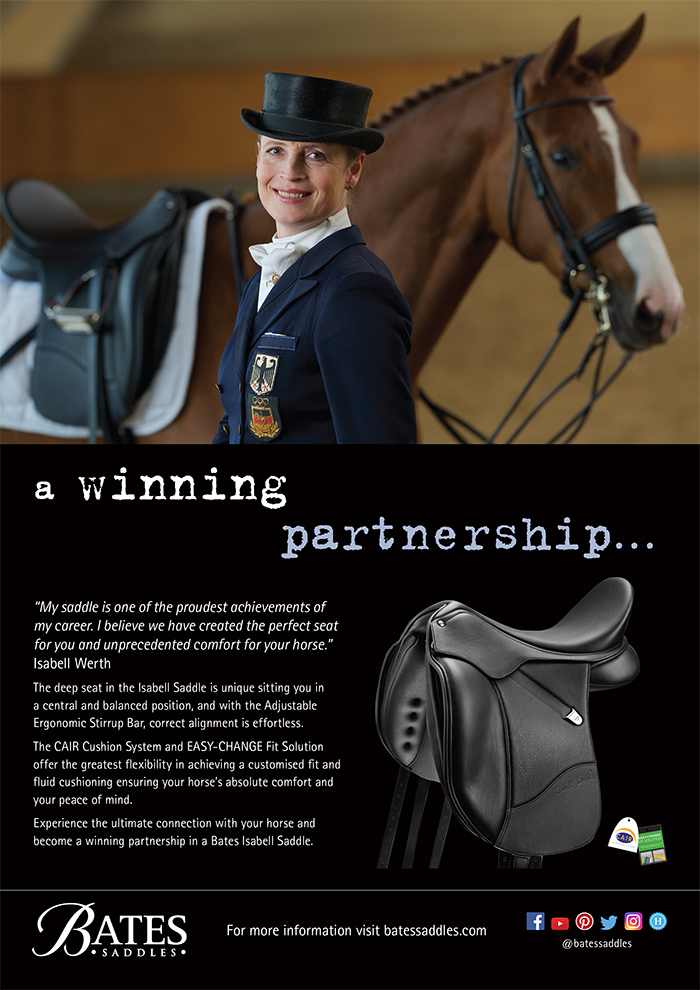
Continuing in that line of thought… “This horse has a top class hind leg, always even and active with both hind legs. And next long side, sitting trot and transition to walk, without rein. As little rein as possible. It was not perfect but it is on the way. One of the important ways to avoid killing a horse in its first stages of training is to school it correctly in the art of transitions. And when you look at it from the instructor’s point of view, the rider has to get the feeling from the trot to ride into the walk. Not make the horse short in the neck using the reins to come into the walk. NO. It needs to be in the opposite way. Giving driving aids, opening the neck, giving reins and without reins a little voice and then walk. This you have to school from the very beginning.”
“We have all seen it when the rider uses the reins, the horse is short, the walk steps are short and there is tension and the harmony between the horse and rider from the trot work is gone. Therefore even though the transition Matthew rode was not perfect, it was made exactly in the right way.” Another transition… “And did you see, it was super! With his body language he said walk. And very sensibly, he was not fighting against the horse saying, ‘you have to do it’, no he was just coming into the saddle and then the horse understood, walk. I think from the rider’s point of view we have to keep in mind we are a guest. I am a guest on the horse, as we are when we visit friends for dinner. I am not at home, I cannot say what I want like when I am in my apartment. When you have this in mind you have another feeling, how to train the horse. And the way he did do it and rode the transition from trot to walk was very sympathetic, he is a guest on horseback.”
Alexis Hellyer and Waca W
Nineteen-year-old Alexis Hellyer, hailing from the Hunter Valley, provided Christoph with the opportunity to reinforce the same message of harmony. Alexis is riding her six year old, chestnut gelding, Waca W (Weltmeyer). Fresh from top ten finishes in the Medium classes at the NSW State and National Championships, the combination have recently begun competing Advanced. It turns out Christoph is a big fan of Alexis’ riding and the praise was thick and fast (I’ve edited most of it out because “very good” starts to lose it’s effect after the 2000th time). “Everything is ok, good. That’s right, stretch the neck. Everything is fine. This is the kind of horse that has to move, the longer you trot him the better he will go. The ground is a bit hard, therefore give him a chance, don’t ask more than is possible, he has to find a good balance. Change the rein quite often, make the feeling nice and keep it as easy as possible. He looks to the right a little bit easier. Nooonono you don’t need the whip! Soooo. Ja, you’re well trained with your soft inside rein.”
“And now we have the feeling the horse is coming into better balance, and now help him with the left side a little bit. Ja, so! Help, but not fight against him, that would be wrong. Change the rein again and then some canter work. Ok, not a perfect transition, but let the horse go forward a bit, a clear three beat rhythm. You are ready to develop, because the first steps of the scale of training are very good. It’s a very good way you ride your horse with your position, with your body language. Change the rein, flying change. Good, come on, maintain the canter. Very nice position, very effective sitting. Alexis what you can do is keep your leg down and ride not so much with your spurs.”
story continues below the advertisement
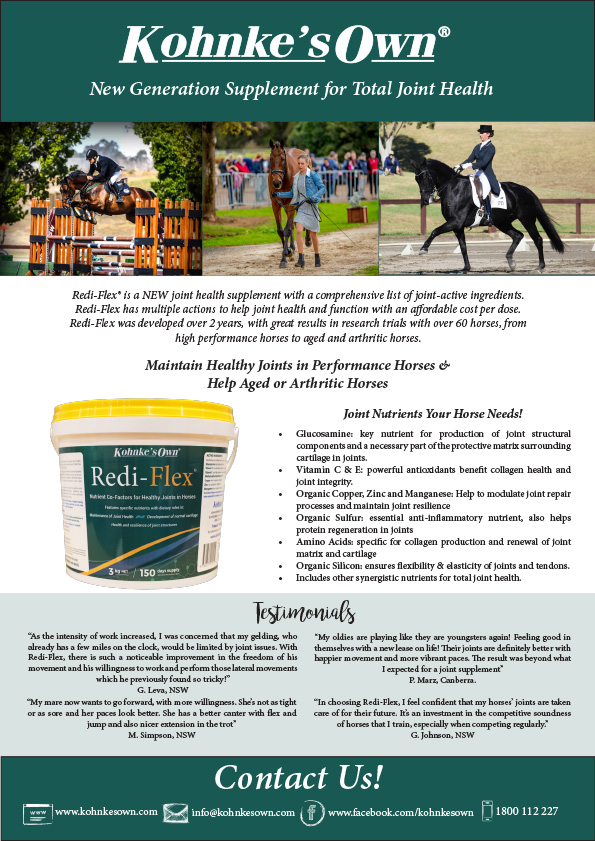
Smoothly easing out of the warm-up an interesting exercise develops… “Ok, circle and then serpentines, three loops, when crossing centreline flying change. Very good. Now four loops and three flying changes.” The first change – “well done”, second – “uh, late behind, kick him, NOT with the whip, a little more leg”, third – “good.” “Ok, now five loop serpentine with four flying changes. Be careful from left to right.” Alexis rides more assertively forward… “Ja, super. Very effective the way you did it. And now, a circle to help you concentrate and now six loops, with five flying changes. Which is really difficult. You don’t need the whip you have such a strong and well-balanced position. Wow. Walk, short break, long rein. This is high quality riding! Maybe you ride a little too much with your spur… You have short legs and often this is quite good but you do not need such long spurs. He has to be obedient to your leg and then the spurs are second.”
The warm-up now decisively completed, the proper work is set… “Ok, now we start with canter work. Oh ja, just wait. The first thing I saw, you’re stopped and then you walk and you make kick, kick, kick, kick for him to take half a stride. No, no, no, no, with your LEG! Wait, give me the whip, you don’t need it. You need your legs to be more effective and then you can use your spurs. Aaah come on! He has to listen.” Alexis makes Waca sharp to the leg by repeating halt- walk transitions and then does the same with walk to canter.
“So now, when you have a good feeling you can start. Three flying changes on the diagonal. Not in series, just whenever you have a good feeling a flying change.” I can almost hear Alexis saying ‘easy peasy’! As with the serpentines the progression is quick and consistent: “circle and then every fourth stride. Well done, pat the horse. Circle and then every three strides.” At this stage Waca has lost the spark from the first changes that came with the new sharpness to the leg. Christoph continues fluently as if it had been pre-planned that this would happen. “Circle and Alexis, medium canter on the circle. In the flying changes, the horse has to go a little bit more forward. In the flying change itself he’s a little behind your driving aids. Try and think I want to ride medium canter in the flying change!”

The change seems effortless and you can almost hear the brows of the small group of spectators collectively knit… “And come again and take your reins in one hand then you sit more proper. You have to give these aids with your body language then you can sit in these movements a little bit more proper. Ja, very good. Next time five flying changes every third stride with reins in one hand. Only sitting and giving your aids, ja very difficult. Ja! Pat the horse. Stay on the circle really, really good! Only with your body language you give the aids. Reins in one hand and pat the horse and now flying change and pat the horse. Ok, once more. Three every third stride and pat him. It’s a good coordination for you to be quick enough then you will have no problem with the next flying changes.” Reflecting on this, I realise it is just an age-old, common sense teaching principle. Practicing something in a way that is more difficult than when you compete should allow the performance in competition to be superior to what it would have been.
Waca really reminds me of a businessman. Sunday equals a day of rest and relaxation. Monday it’s back into action and true to form he is a bit strong and hot. “Ja, careful that he’s not leaning on the bit. And now serpentines, three loops please. Flex him right and flex him left and inside leg enough that he is really supple while flexed and bent. And once more, five loops. And if he’s too strong when you are crossing the centreline, walk. Don’t accept that he is too strong. That is great. And then trot again and then walk again.” Rather than trotting-on Waca wants to get moving and canter… “No problem, come with your leg, (he canters again), no problem. And again, both legs. Ja. That’s very good you have super influence in the saddle. It’s good when he’s under pressure, yesterday he was a little bit lazy when you wanted to trot him. You were asking and nothing happened, now we have a positive reaction. Both legs. Ja. And Alexis, if you have a problem like this, a shoulder in for this situation. And now he’s 100% under your control. So, this is a good way to develop his trot.
At the risk of sounding like a corny teenage girl with a crush, it wasn’t just Christoph’s overwhelming teaching skills that struck such a chord with riders and spectators alike, it was his endearing exuberance for life; his boyish mannerisms (like incessant whistling, and light-footed bounding across the arena with a little hop over the fence) which brought a smile to even the most sullen faced cynics. Even a sense of humour that the non-Germans appreciated: “Who was the trainer who trained you in the beginning? Silva Stigla. Oh, you have a good position as well (as well as Robbie Soster, another clinic participant). Here are two young ladies, nineteen years both and with wonderful positions! Wonderful positions here in New South Wales… I think in Old North Wales people are not sitting as well as in New South Wales! (To Carlos) Agreed? In Belgium and Germany it’s not so good? …Your students, ahh of course! The best Belge are outside Belgium, no?”
story continues below the advertisement
t
After some more joking he continues the lesson, still in good humour. “So! Very good!! Come, come, come! Less inside rein. Change the rein left and shoulder in left. Try to maintain a good swinging trot rhythm. And then half pass left. Look here into the direction you are riding. And circle at B and inside leg!! And shoulder in again. Repeat. And then half pass, look into the direction with your eyes. So, come, come maintain the big gaits. Shorten the reins and stay on the circle. Next time on the open side of the circle, lengthening the steps and you prepare here at the closed side of the circle. Good.”
Alexis walks. “Brrrrrtt what we do on the left side we do on the right side! You could work in a German office, they always stop working after five minutes! Good, then medium trot on the open side of the circle. Give inside rein, so! Ok, rising trot, slow down the tempo a little bit and let the horse stretch. You do a great job! Good, ok and then transition to canter and use the whole arena and the rein as long as possible. And transition to trot and that’s enough for this horse.” 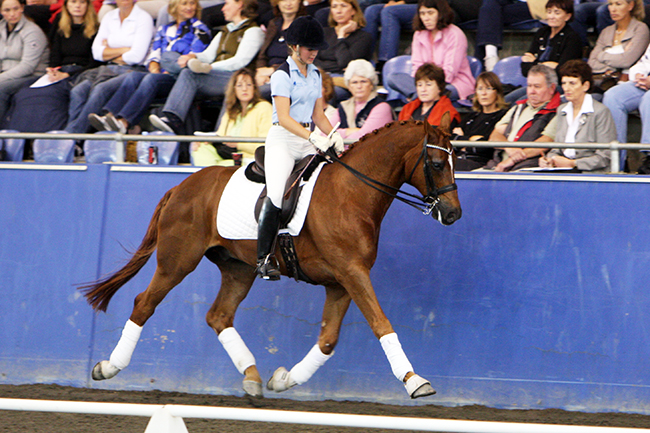
Razzmatazz and Robbie Soster show the long frame and forward technique to get the horse to stretch through the body
Question from the crowd:
“I’m quite new to Dressage, I come from a different equine background, but in the last couple of years we’ve had some young horses training with my partner and we came up to watch the young horse classes here this year… and I’m a little confused now. I watched you today and watched your training methods and the skills displayed, but I find that when I came and watched the young horse classes the horses already had a manufactured FEI frame. And so we watched the results of that and they were marked quite high and came in at the top. I had only a couple of years experience and it was explained to me that Dressage was a combination of the horse and rider, mostly riding from the body and not through the hands. So, for me, I went home with my partner and said ‘Geez, we’ve got to start riding these horses more in a competition frame because that’s what will win’. So for me it’s a little confusing and I would like to see what you showed today and suggested should receive high marks, especially the last horse (Waca W), you said that he wasn’t a great mover but the trainability of the horse was fantastic and I think that the judges should encourage exactly what you said, because I think that’s the only way to develop the sport. I take this home now, and I hope the judges take home some of the things you have shown here today, because I think it’s very important!”
“Ja, thankyou very much for these words… I think Carlos you watched the German association before you came here to this beautiful country and you know it a little bit as well. I judged the very first young horse championship we had in Germany in 1989. For horses five and six years old, and now we had it the for 20th time in 2008, and I have always been the judge who gives the comments (over the public address, at the end of each finalist’s test) and I think the judges have to change, but not a lot. My best friend of the young horse judges, Dr Dieter Schüle, was the Olympic judge for Athens and he is quite often here in Australia as well, we discuss it very often and we are more or less always sitting together when we have these German championships for young horses. And I think, what you are saying, that is right. I think in the old days we were sometimes looking too much to the spectacular movement and too much…ja, as you say FEI attitude.”
“And now we have changed hopefully, and spectators say there has been a change, in the way of looking at these young horses. So that the relaxed horse, and the last horse is a good example of this, now a six year old, ok and now ridden with a double bridle, not a super mover, but very well presented. I think in the old days this horse wouldn’t have had the chance that it has now. Now, we look much more to this direction, the sport has to develop. And the judges are very important to develop the sport. Very important! If they develop in the wrong direction then it’s bad for the sport in total. Therefore, we took the step to look more to these things, and less to the super, top class quality movement that showed tension. Horses, which have this spectacular movement are not 100% supple. Therefore we made a change, and maybe you need to think about it in Australia, although I wasn’t here for your young horse show.”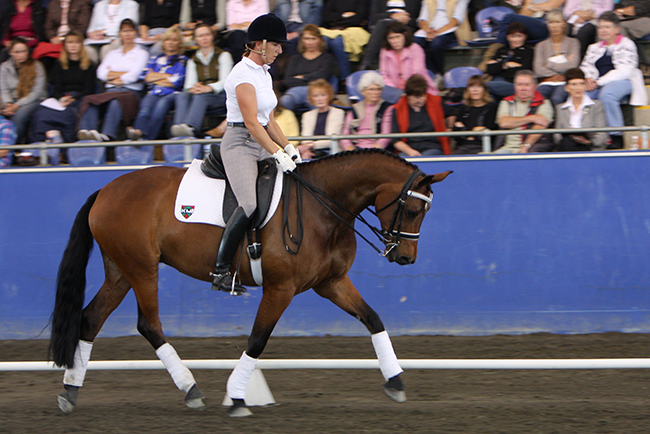
Lizzie Wilson Fellows shows the stretching frame that lead to movements from the Inter I test
“Maybe this is a process… and I am happy that you pointed this out because this is important! A judge, or two judges sitting together can give a wrong direction if they only want to see a horse with an FEI attitude. Nicht? Ok, on the other hand I have to say it that… a horse needs a little bit of positive tension as well, positive tension. The German word is Spannung and the wrong tension is Verspannung. Therefore, when we are discussing relaxation and suppleness, the horse has to be supple, but a little bit with positive tension. If it is only supple, then it trots all over the place. And if, for instance you ride the free walk with a very long rein then without positive tension, the horse goes too free.”
“The horse needs a little bit positive tension, this is important to see what is positive tension and when negative tension starts. You have to school your eyes to see this, and it is very necessary that judges discuss these points very carefully. I am responsible together with Chris Bartle (who is a great guy and has often been in Australia), we have been responsible for the new FEI Eventing tests. And in the beginning Chris always used the term, free walk. Free walk on a long rein. We were discussing it, very friendly because he’s a great guy, super guy! And I always said that I don’t think that it’s a good interpretation, and I want to explain it with the walk. We need horses that are well stretched but that the rider has a contact with. So, not a free walk and the horses are going like a drunken person, no. But that the horses have a balance and there has to be a steady contact between the horse’s mouth and the rider’s hands. The horse has to seek the bit and stretch the neck and has to walk in that way for a 10. So we have a free walk, but with contact!”
This article first appeared in the March 2009 issue of THM.
